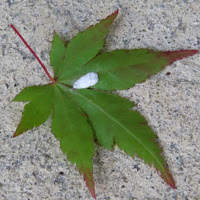"I dream my painting and I paint my dream."
- Vincent van Gogh
 |
| Beth Chatto's water garden at Elmstead Market |
Winter is certainly a time for dreaming - and reflecting on events and impressions over the past year.
 |
| Neatly labelled plants at Beth Chatto's garden centre |
It was a kind of pilgrimage for us to finally arrive at the former home of that doyenne of English gardening style, Beth Chatto.
We were on our way to visit Christina's cousin in Suffolk, having braved the M25 for the first time in 14 years, and reckoned this might be our one and only chance to see the famous gardens and plant centre at Elmstead Market.
An eye-catching display of echeverias and sedums was almost the first thing to greet us on arrival at the garden centre...
What better use for all those ancient, spider-infested terracotta pots we'd been hoarding?
They might be useless for thirsty seedlings, but for designer-succulents sunk in gritty compost they are absolutely perfect! We chose a few in 'hommage' to Beth's inspirational book on gravel gardening and have brought them home to admire through the winter.
For the time being, we've grouped these together in an old copper pan, to complement its bluey-green verdigris; but later we can transplant any offshoots into individual clay pots and make another display.
Despite an icy autumn wind blowing off the North Sea, we enjoyed strolling through Beth's garden centre which is zoned into different areas, providing a short-cut for those of us with a particular soil type. Her restaurant and tea room are warmly recommended as a culinary haven on a cold day!
 |
| Gravel-loving succulents to tempt the eye |
What better use for all those ancient, spider-infested terracotta pots we'd been hoarding?
They might be useless for thirsty seedlings, but for designer-succulents sunk in gritty compost they are absolutely perfect! We chose a few in 'hommage' to Beth's inspirational book on gravel gardening and have brought them home to admire through the winter.
 |
| Clockwise from top left: Hebe pagei; Sedum Cape Blanco; Sedum dasyphyllum; Raoulia australis lutescens group; and (centre) Limonium bellidifolium |
For the time being, we've grouped these together in an old copper pan, to complement its bluey-green verdigris; but later we can transplant any offshoots into individual clay pots and make another display.
Despite an icy autumn wind blowing off the North Sea, we enjoyed strolling through Beth's garden centre which is zoned into different areas, providing a short-cut for those of us with a particular soil type. Her restaurant and tea room are warmly recommended as a culinary haven on a cold day!
 |
| Archetypal 'prairie planting' at the Beth Chatto gardens |
Inspiration comes almost subconsciously from visiting gardens, looking at artfully arranged photo-shoots in magazines and from certain historical styles such as the parterre...
 |
| Part of the Cherry Garden at Ham House, London, with statue of Bacchus as a centrepiece |
All that careful clipping of santolina, lavender and box would be a near impossible task for the amateur; but with battery-operated cutters it's not unfeasible to create something on a smaller scale.
It demonstrates in a very striking way the appeal of repeated design and understated colour, allowing light to be paraded as form.
 |
| Polianthes tuberosa - a heady scent from times past |
On our tour she showed us this statuesque lily-like flower being grown in a pot. Known as the 'tuberose' and used for centuries in perfumery, it's not a rose at all but a tuber related to agaves, native to Mexico and producing clusters of waxy flowers on spikes up to 45cm long.
Its fragrance is unforgettable and I've looked up a supplier online as it's unlikely to appear in a garden centre around here.
 |
| Classic ochre pots, tastefully displayed at Petersham Nurseries |
As a thriving temple to the art of shabby-chic, it doesn't disappoint! This is a style which still thrives in parts of France, particularly Provence where there is more of a Roman influence, but has yet to make a comeback in the garden centres of Charente Maritime.
If you're lucky, these half-glazed olive pots can still be found at local brocantes - but you'll need to haggle!
 |
| Green glazed pots as a foil for begonias |
These dark-leaved begonias would look unappealing against terracotta, but a contrasting pale glaze shows off their colour and shape to perfection.
I particularly hate the craze for those plastic pots in fluorescent lime green or fuschia which are ubiquitous in French garden centres.
Maybe they look effective on a balcony or in a small courtyard, but in rural areas they're about as subtle as a flamingo set amongst lapwings, crudely clashing with whatever poor plant has been stuck on top!
 |
| Pots that won't detract from flowers and leaves |
 |
| Romantic 14th century Scotney Castle in Kent |
We stayed with another cousin - Barbara - in nearby Tunbridge Wells and she treated us to a day out visiting two of the National Trust properties with photogenic gardens.
 |
| A seasonal display of plants and shrubs |
As with Beth Chatto's enterprise, a real effort has been made to provide clear and interesting information for both the novice and more experienced gardener.
(Visitors ask the same questions all the time, so why not make things like plant names as visible as possible?)
Aside from the naturalistic gardens around the part-ruined castle, lake and moat, there is also an extensive nursery which is well worth exploring.
 |
| Dahlia 'Twyning's After Eight' (with RHS Award of Garden Merit) |
If I could opt for just one, I think I'd pick this more restrained white variety with its single flowers up to 8cm across, and dark almost black foliage. Yum!
Now that Chiltern Seeds new catalogue has arrived, we're all set to dream away those long winter evenings...










































